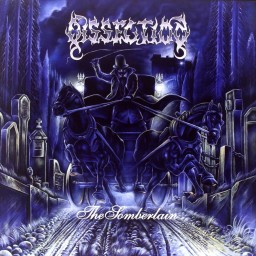 Review by Ben for Dissection (SWE) - The Somberlain (1993)
Review by Ben for Dissection (SWE) - The Somberlain (1993)
Groundbreaking album that kicked off a subgenre while nailing it on the first attempt.
It wasn’t until late 1992 when the band began working on their debut album, that the infamous Dissection sound was fully formed. Due to problems coordinating all the guys from various locations, the entire band had shifted to Gothenburg, Sweden, where they shared a rehearsal space with the band At the Gates. I think it would be wrong to assume that this move to the home of melodic death metal, or the time spent with one of its establishing forces, were the catalysts for the melodic elements that entered Dissection’s sound around the same time. After all, while Dissection’s early work (The Grief Prophecy demo and Into Infinite Obscurity EP) were predominately straight forward death metal releases, they unquestionably had small touches of both the melody and the black metal that would eventually come to the fore in their sound. It’s more likely that Nödtveidt’s love of black metal and Zwetsloot’s background in classical guitar were the influences that drove Dissection to create something that, at the time anyway, was unique and groundbreaking. There’s no doubt that Nödtveidt was the main composer and lead guitarist for Dissection, but it was Zwetsloot that deserves credit for introducing the dual harmonies and the classical interludes that fill both of their classic albums, despite only taking part in the recording of The Somberlain.
Released in December 1993 and formally dedicated to the recently murdered Euronymous, The Somberlain stands as one of the more significant albums in the development of black metal. At this stage, melody wasn’t something often associated with the genre, and I’m not sure too many people in the scene considered it would ever play much of a role. Bands such as Darkthrone had taken the raw and nasty approach and others like Burzum had upped the atmosphere and melancholy to new heights, but The Somberlain showed that it was more than feasible to integrate melody without sacrificing any of the pure venom and majesty that the genre of black metal pretty much demands. Bands like Naglfar, Vinterland and Sacramentum owe their existence and success to The Somberlain, and its influence can also be heard in many of the melodic death metal albums that would shortly follow. The overriding atmosphere can be described as majestic and cold, with the razor sharp riffs combining perfectly with Nödtveidt’s raspy harsh vocals. This icy tone is beautifully captured visually by Kristian Wåhlin (aka Necrolord) with what is one his finest album cover efforts, giving more credence and mystery to the darkness contained within. The lyrics complete the package, describing shadowy lands and evil deeds, giving the listener numerous elements that form one distinct identity.
It has to be said though that despite how revolutionary and successful The Somberlain was on the first attempt, Dissection would substantially surpass it with the follow-up Storm of the Light’s Bane. There are two main reasons why I can’t rate the debut the full marks that its successor demands. Firstly, the three classical interludes by Zwetsloot are clearly meant to break the album up and give a bit of breathing space, but when focussed on individually are unnecessary and just a bit too pleasant to fit the tone of the surrounding malevolence. More importantly though, I don’t think Dissection had quite enough high quality material to keep the standard going for the whole 45 minutes. The first half contains sublime epics like Black Horizons, the title track and Heaven’s Damnation, but I think only Cold Winds of Nowhere comes close to matching them in the second half. Frozen has a fairly dodgy lead that threatens to ruin an otherwise decent track and The Grief Prophecy / Shadows Over a Lost Kingdom is a re-recording of old material that doesn’t quite compare to the new material. Flaws aside, The Somberlain deserves recognition for expanding the boundaries of black metal while being a thoroughly absorbing release in its own right. The recent two disc reissue by The End Records that includes the band’s demo and EP along with live and rehearsal material makes it an even more essential release.
